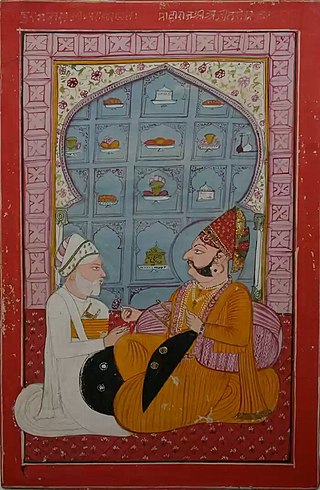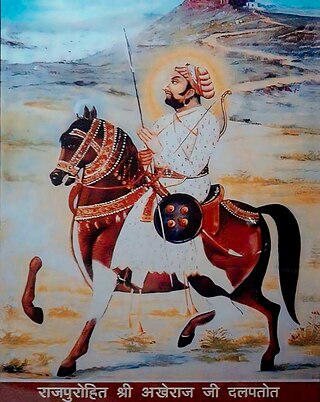Related Research Articles

Marwar is a region of western Rajasthan state in North Western India. It lies partly in the Thar Desert. The word 'maru' is Sanskrit for desert. In Rajasthani languages, "wad" means a protected area. English translation of the word 'marwar' is the region protected by desert.

Durgadas Rathore was the Rathore Rajput General of the Kingdom of Marwar. He is credited with having preserved the rule of the Rathore dynasty over Marwar, India, following the death of Maharaja Jaswant Singh in the 17th century.

Rao JodhaRathore was the 15th Rajput chief of Rathore clan who ruled the Kingdom of Marwar in the present-day state of Rajasthan. He was the eldest son of Rao Ranmal. He is known for his illustrious military career and for founding the city of Jodhpur in 1459, which subsequently became the new capital of Marwar after Mandore.

Merta City is a city and a municipality located, near Nagaur City in Nagaur district in the Indian state of Rajasthan. Merta is also known for its link with Mira Bai, the devotee of Lord Krishna. Mira Mahal Museum houses memories related to Mira Bai's lifetime
Rajasthani literature is an tradition in Indian literature dating to the 2nd millennium, which includes literature written in the Rajasthani language. An early form of Rajasthani started developing in the 11th century from Saurseni Prakrit as Maru-Gurjar or Gurjar Apabhramsa. Early Rajasthani literature was usually written by Charans. Earlier Rajasthani was known as Charani or Dingal, which was close to Gujarati. Medieval Rajasthani literature was mostly heroic poetry mentioning the great kings and fighters of Rajasthan. Rabindra Nath Tagore, a Bengali polymath, once said, "The heroic sentiment which is the essence of every song and couplet of a Rajasthani is peculiar emotion of its own of which, however, the whole country may be proud". It is generally agreed that modern Rajasthani literature began with the works of Suryamal Misran, including the Vansa Bhaskara and the Vir Satsai. The Vansa Bhaskara contains accounts of the Rajput princes who ruled in what was then Rajputana, during the lifetime of the poet (1872–1952). The Vir Satsai is a collection of hundreds of couplets.

Charan is a caste in South Asia natively residing in the Rajasthan and Gujarat states of India, as well as the Sindh and Balochistan provinces of Pakistan. Historically, Charans have been engaged in diverse occupations like bards, poets, historians, pastoralists, agriculturalists and also administrators, jagirdars and warriors and some even as traders.
Barhath Kripa Ram Ji Khidiya (1743–1833) was a famous Rajasthani poet of the 18th century. He is known for his soratha on ethics (नीति) called 'Rajiya Ra Soratha' and 'Rajiya Ra Doha'. In addition to his ethical writings, the poet's other works are concerned with devotion to God and heroism.

Dursa Arha was a 16th-century warrior and Rajasthani (Dingal) poet from India. He earned the epithet of the 'First Nationalist Poet Of India' or Rashtrakavi because of his nationalist stance in his bold Dingal poems commending Maharana Pratap of Mewar in his struggle against the Mughal Empire. He is one of the most highly regarded poets of the time, who was also a valuable and respectable part of the Mughal court. He was a renowned litterateur, historian, war general, consultant, administrator, feudal lord, and magistrate. He had close relations with the rulers of many erstwhile kingdoms. On the basis of wealth, fame, and honor Dursa Arha acquired in his lifetime and his contribution to medieval Indian history and literature, the historians and litterateurs consider him as one of the greatest poets. Dursa Arha attained heights of opulence and grandeur reached by no other poet in history.
Rana Lakha was the Sisodia Rajput ruler of Mewar Kingdom .He was the son of Rana Kshetra Singh and ruled Mewar from 1382 until his death in 1421.

Sawai Raja Soor Singh or Suraj Mal or Suraj Singh, was the ruler of the Rathore Kingdom of Marwar .His sister Manawati Deiji/Bilqis Makani was the consort of Mughal Emperor Jahangir and mother of his successor Mughal Emperor Shah Jahan.
Rao Ranmal, also called Ran Mal or Ridmal, was the Rathore ruler of Marwar. A notable expansionist and skilled warrior, Ranmal is also noteworthy for having twice served as regent of the kingdom of Mewar under two different kings.
Bhanwar Singh Samaur is an Indian writer, poet, historian, and social worker from Rajasthan. Samaur is the recipient of the Sahitya Akademi Award 2020 for his work Sanskriti ri Sanatana Deeth. His career has spanned more than 50 years including works on history, literature, and poetry in Rajasthani as well as Hindi. Dr. Samaur is a retired Hindi Lecturer from Lohia Postgraduate College, Churu.
Alhaji Barhath, or Alhaji Rohadia, was a Rajasthani poet, warrior & horse trader known for providing shelter to Rao Chunda of Mandore during his childhood, who is credited with laying the foundation of the Rathore rule in Marwar.
Nainsi ri Khyat is a late 17th-century Marwari & Dingal text chronicling the history of Marwar. Its author Muhnot Nainsi, an official of Marwar State, based the Khyat on the Charan accounts and the traditional Rajasthani Vat(or bat) as well as local administrative records. Nainsi-ri-Khyat is considered to be the most prominent of khyats. The Khyat contains a collection of bats as well as kavitts, dohas, and vanshavallis (genealogies).
Ratnu, also spelt as Ratanu or Ratnoo, is a major clan of the Charanas in Rajasthan.
Haridas Kesaria or Haridas Mahiyaria was a 16th-century Mewar chieftain, warrior and poet from Rajasthan. In the Battle of Gagron in 1519, he fought alongside the Mewar army led by Rana Sanga, capturing and imprisoning the Sultan Mahmud Khalji II of Malwa, thus quickly ending the war. He was a close friend of Rana Sanga, participating in many battles and campaigns of Mewar kingdom. He fought as a commander in many battles including Battle of Khatoli, Battle of Gagron, Battle of Dholpur, Rana Sanga's invasion of Gujarat, Battle of Bayana and Battle of Khanwa in which he sacrificed his life on the battlefield while defending Rana Sanga.
MahamahopadhyayaKaviraja MuraridanAshiya served as the Dewan of Marwar during the reign of Jaswant Singh II (1873–1895). Kaviraja is remembered as an astute politician and a farsighted administrator, who made significant contributions to the history of Marwar. He was a Tazimi sardar (noble) and a renowned scholar, known for his prominent works including Yaśavaṃta-Yaśo-Bhūṣaṇa and Tawarikh Marwar.
Sasan was a tax-free land grant given in the form of either partial or whole villages to the Charanas by rulers in medieval India. These grants were given in perpetuity and enjoyed superior rights compared to other land tenures.

Akheraj Singh Rajpurohit or Patshah Akheraj ji was the Rajguru and Sardar in the royal court of Marwar during the reign of Maharaja Jaswant Singh and Maharaja Ajit Singh.
References
- ↑ Datta, Amaresh (1987). Encyclopaedia of Indian Literature: A-Devo. Sahitya Akademi. ISBN 978-81-260-1803-1.
A few of the prominent sub-castes which have produced good poets, are- Asiya, Adha, Kaviya, Vithu, Dadhawadiya, Gadana, Lalasa, and others.
- 1 2 3 4 Mevaṛa itihāsa ke katipaya pahalū (in Hindi). Pratāpa Śodha Pratishṭhāṇa. 1995.
- ↑ Sāmaura, Bhaṃvara Siṃha (1995). Śaṅkaradāna Sāmaura (in Hindi). Sāhitya Akādemī. ISBN 978-81-7201-867-2.
- ↑ Swami, Narottam Das (1956). Bankidas-ri-Khyat. Jaipur: Rajasthan Oriental Research Institute.
- 1 2 3 Bhāṭī, Hukamasiṃha (2021). Rajasthan main bhoomidaan pranali (in Hindi). Rājasthānī Granthāgāra. ISBN 978-93-91446-21-5.
- 1 2 Qanungo, Kalika Ranjan (1960). Studies in Rajput History. S. Chand.
- ↑ Ram, Lala Sita (1920). History of Sirohi Raj, from the Earliest Times to the Present Day. Pioneer Press.
- ↑ Bhati, Hukam Singh (1995). Rājasthānī Aitihāsika Dohe (in Hindi). Udaipur: Pratap Shodh Pratishthan, Bhupal Nobles' University.
- 1 2 Jigyasu, Mohan Lal (1968). "4". Charan Sahitya ka Itihas - Volume 1 (in Hindi). Jain Bros.
- ↑ Śekhāvata, Saubhāgyasiṃha (1980). Īsaradāsa nāmaka vibhinna Cāraṇa kavi (in Hindi). Rājasthāna Sāhitya Samiti.
- ↑ Jigyasu, Mohan Lal (1968). "5". Charan Sahitya ka Itihas - Volume 1 (in Hindi). Jain Bros.
- ↑ Agravāla, Govinda (1974). Cūrū Maṇḍala kā śodhapūrṇa itihāsa (in Hindi). Loka Saṃskr̥ti Śodha Saṃsthāna.
- ↑ Siṃha, Rājendra (1988). Bīdāvata Rāṭhaudoṃ kā itihāsa (in Hindi). Yūnika Treḍarsa.
- ↑ Sāmaura, Bhaṃvara Siṃha (1995). Churu Mandal ke Yashasvi Charana (in Hindi).
- ↑ Seva, Samachar (2018-08-10). "अखिल भारतीय चारण समाज के अध्यक्ष सी.डी. देवल की अध्यक्षता में गांव चम्पानगर में 22 अगस्त को होगा धाटपारकर चारण समाज का प्रतिभा सम्मान समारोह". Samachar Seva. Retrieved 2024-03-07.